Introduction
Hey, everyone, how's it going?
In the Card Game World, we saw in July the release of Bandai's newest game: the Gundam Card Game!
Gundam has mechanical similarities to other well-established card games. It has damage counters that resemble Pokémon; the attacking steps are very similar to One Piece TCG, where you only attack rested cards; another similarity to One Piece is the resource system, where you add them from outside the game, one more each time you start your turn; lastly, there is interaction during combat, with players able to use cards on the other player's turn, as in Magic: The Gathering.
If you're unfamiliar with the franchise, Gundam is an anime series created in 1979, that features several episodes set in a futuristic universe where Mobile Suits (MS)—high-tech battle mechas piloted by humans—are used in warfare and the focus of the franchise's storyline. Bandai has brought these conflicts from the series to the card game.
In today's article, we'll cover the basics of the game, phases in a turn, and keywords.
How to Play Gundam CG?
The game's basic premise is that each player commands a battle station, represented by the deck, and they'll face each other, attacking and defending their base.
Deck Building Rules
Each Gundam Card Game deck may use at most two colors out of the four available. Any card type within the chosen colors can be used - Unit, Pilot, Command, and Base cards.
The deck has a maximum of 50 cards, and each individual card has a maximum of 4 copies.
Card Types
Unit - These are combat units and are the main way to attack your opponent.
They are played in the Battle Area, displaying color, type, costs, level, abilities, zone, characteristic, link, attack power (AP), and health points (HP).
Example:
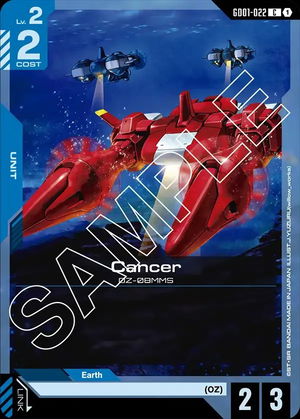
Pilot - These are cards that enhance units, by having a skilled person controlling the Mobile Suits. They display color, type, cost, level, abilities, characteristic, pilot, attack power (AP) bonus, and health power (HP) bonus.
Example:
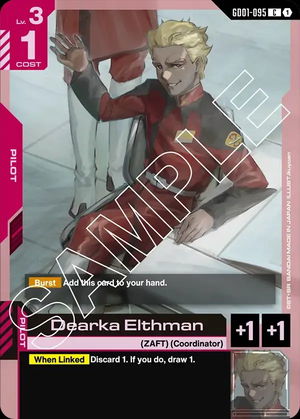
Command - These are cards that generate an effect, and afterwards go to the discard. For those familiar with Magic, this would be the equivalent of Sorcery or Instant. Some Command cards can also be played as pilots, allowing for versatility depending on the game.
Example:
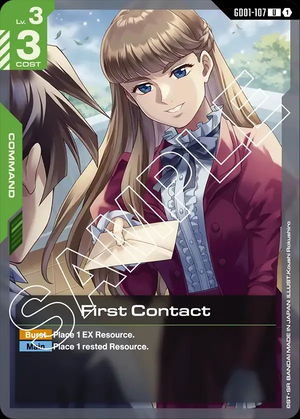
Base - These are protection cards that go in the Shield Area. You can only have one base at a time, and you must discard the current one when a new one is played. Some have abilities beyond their defensive status, making them essential for some strategies.
Example:
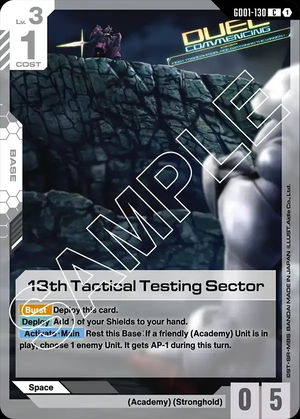
Now that we know the card types, let's introduce the game's layout.
Game's Layout
Here's the official playmat with each game zone:
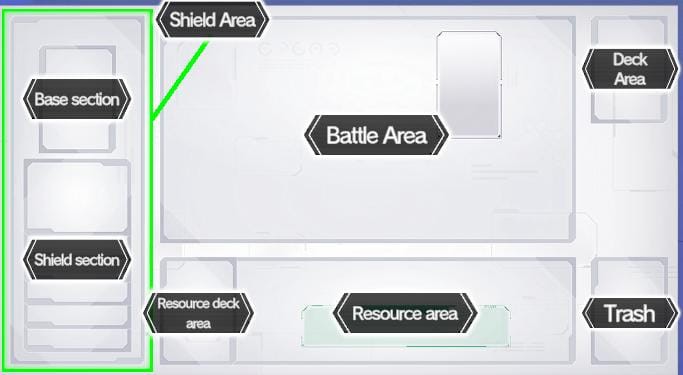
Resource Deck - This is where our resources are stored, which are added to the Resource Area each turn.
Resource Area - This is where our available resources are used.
Shield Area - This is our protection from enemy attacks. We start with a 3 HP base, and six shield cards.
Trash - This is where cards go once they are used, destroyed, or discarded.
Deck Area - This is where we put our deck.
Getting Ready to Play!
Choosing first player
Using a random method, like a dice roll or rock-paper-scissors, determine who will play first.
Setting up for Battle
After shuffling and cutting the opponent’s deck, each players draws five cards.
Players are allowed to redraw their starting hand, putting the five cards already drawn at the bottom of the deck, and then drawing the next five from the top of the deck. This can be done only one time, so the new hand is the final one.
Afterwards, you shuffle the deck and put 6 cards from the top in your Shield Area, and an EX Base afterwards. The non-starting player adds an EX Resource to their Resource Area.
This is the game’s setup! Now, let’s understand how the turns play out.
Resources and Level
To play cards, you must pay their Resource cost, by resting the appropriate amount of unused Resources. There’s also another thing to watch for, which is the Resource Level, also shown on the cards. Your Resource Level is the total number or Resources you control in the Resource Area. So, for example, if you have 1 Resource in the Resource Area, it’s possible to play Dopp, because its Cost is 1 and its level is 1, but can’t play Zaku II, even though it is 1-Cost, because it requires Level 2.
EX Resource
The EX Resource is a one-time use Resource. After used, it leaves the Resource Area. It counts normally towards your Level while it’s in your Resource Area, so the non-starting player will have a Resource and Level temporary advantage.
Turn Phases
A turn has several different phases, which we’ll detail next.
Starting Phase
This is where we ready our Resources and other permanents.
Draw Phase
This is where you draw a card for the turn. Notice that First Player draws on their first turn, unlike a lot of other games where first to play skips the first turn draw.
Resource Phase
This is where you place a Resource from the Resource Deck into your Resource Area, ready to use.
Main Phase
On main phase, there are three possible actions:
1 - Play a card from hand;
2 - Activate an effect;
3 - Attack with a Unit.
The actions can be done in any order, and as many times as the player’s resources allow it.
We’ll detail the Attack a little more afterwards.
End Phase
This phase has an Action Step, where you can play Command cards or activate Action effects.
Then, effects that happen at end of turn are checked. Any temporary effect is no longer active. Lastly, if you have more than 10 cards in hand, you discard until you have exactly 10.
Combat
Once you declare an attack, there are two possible targets: the Shield Area or a rested Unit.
Attack Step
To begin the attack, we rest our attacking Unit and declare where it’s attacking.
Block Step
Next, we go to Block Step. If the defending player has a Unit with the Blocker ability, this is where they may be activated - resting the Unit, and thus changing the attack target to them.
If there are no Blockers, or the player just don’t want to activate it, proceed to the next step.
Action Step
The Action Step’s priority is with the defender, who may play a Command card with an Action timing or activate an Action effect. After the defender, it is the attacker's priority in the Action Step.
The Action Steps continue to alternate until both players pass twice in a row.
Damage Step
After all effects and actions, battling units deal damage equal to their AP (Attack Power) to the opponent's HP (Health Points), and vice versa.
- If the damage to any unit or base is equal to or greater than its HP, it is destroyed.
- If the damage isn’t enough to destroy it, it still remains on the unit or base, until it is dealt the remaining damage or it recovers from damage.
- Shields have 0 AP and 1 HP, and are destroyed if dealt any damage. If we deal damage to an opponent that has no protection in the Shield Area, we win the game.
Pilots
Pilot cards allow us to enhance our Units, buffing their stats and sometimes even granting extra effects once you pair them. They act as supports that allow you to break through stalemates and overwhelm opponents.
Example:
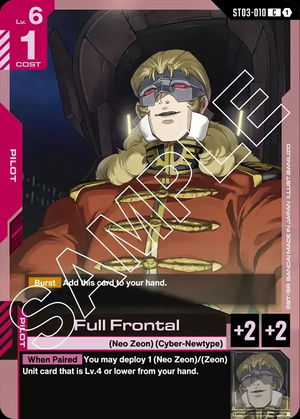
Example:

Link Unit
Link Unit is a special effect that happens when you pair a Unit with a specific Pilot. You can check which Pilot is needed on the Unit itself.
Once paired, they become a Link Unit. This means it can attack on the same turn it is played, instead of having to wait for the next turn.
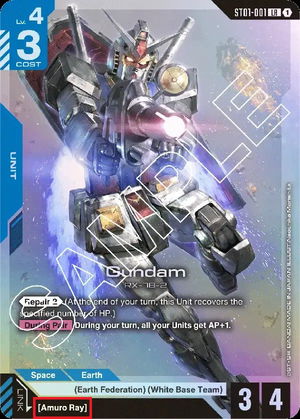
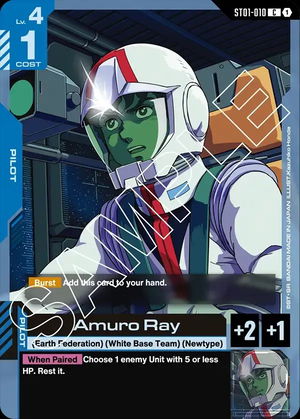
Trait
These are informations about class, organizations, and characteristics in the cards. They are important, since some cards care about using some specific traits.
During deckbuilding, try to have as much synergy as possible with cards from the same type, in order to maximize their usage.
Here's an example:
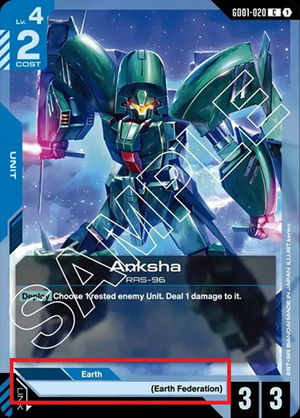
Colors in Gundam CG
At the moment, there are 4 different colors (spoiler: with the release of the next set, there’ll be a fifth color): Blue, White, Green, and Red. Each color has a main strategy to it, which guides their pairing with other colors.
Blue
Focused on tempo plays and control, resting enemy units so they can be attacked, or returning units to the opponent’s hand, delaying their development.
White
Focused on combat and defense, with Blockers and ways to reduce other unit’s AP, preventing the opponent from removing key units from your side.
Green
Focused on ramping resources, allowing you to play higher level cards much earlier.
Red
Focused on combat and attack, with cards that increase AP or deal direct damage to Units.
Keywords Glossary
These are the game’s keywords and mechanics thus far.
Attack
This means an effect that is activated upon the Unit attacks, either the Shield Area, or an opponent’s Unit.
Ex:
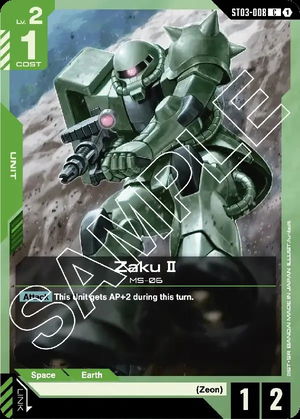
Blocker
A card with Blocker can change an attack target to itself, if able. To activate a Blocker ability, the owner must rest the Unit.
Blockers are an important strategic tool to protect key Units or our base.
Ex:
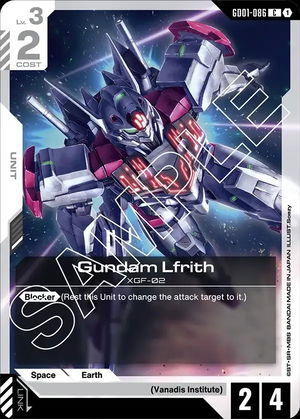
Breach
Breach means that when the Unit destroys an opponent’s Unit, it’ll also deal damage equal to its Breach number to the opponent’s Shield Area.
Ex:
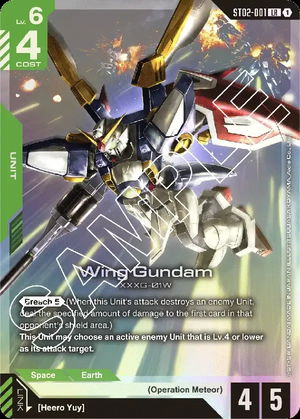
Burst
This is an effect that is activated when a shield is destroyed. If the revealed card has Burst, the player has the choice of activating it.
You must always consider the possibility of activating these effects when attacking the opponent, so it’s important to attack first with lower-powered Units, in case a Base with Burst is revealed and played.
Ex:
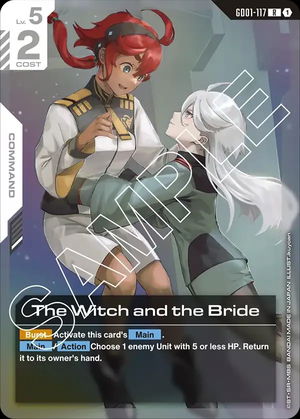
Deploy
This means an effect that happens when you play the Unit. It’s similar to Magic’s When it Enters the Battlefield effects.
Ex:
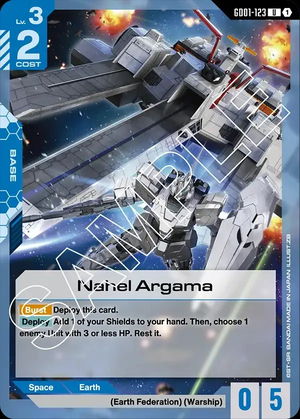
Destroyed
This is an effect that happens when the Unit is destroyed.
Ex:
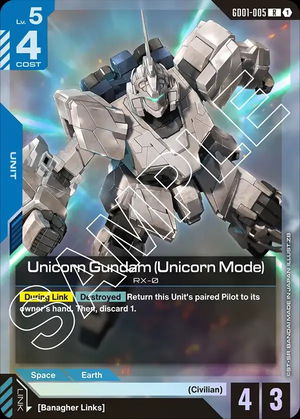
First Strike
This keyword grants the Unit priority to deal damage first in combat, instead of it being simultaneous. This allows for a Unit to destroy another without receiving damage.
Ex:
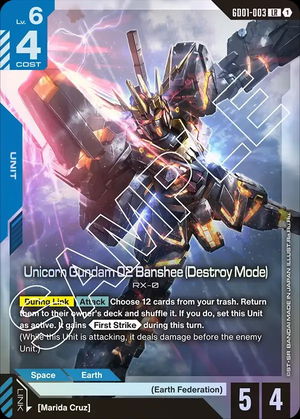
High-Maneuver
When a Unit with this ability attacks, the opponent can’t activate Blockers. This means the attack will always go for its intended target - either the Shield Area or another opponent’s unit.
Ex:
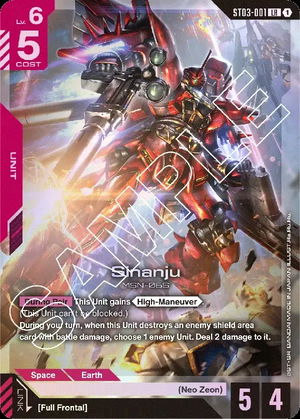
Once Per Turn
This means the ability can’t be activated more than once each turn.
Ex:
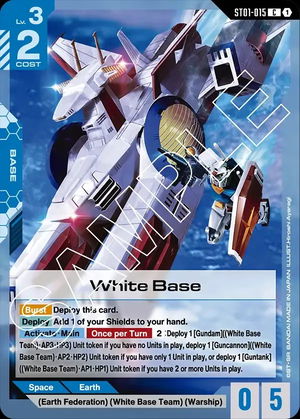
Repair
This is an effect that happens in the End Phase, allowing you to remove damage counters equal to the number next to the Repair ability. Mostly found in Blue cards.
Ex:
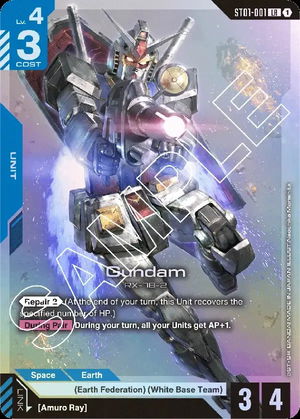
Support
This allows the Unit to increase another Unit’s AP, equal to the number next to the Support ability. The supporting unit must be rested to activate the effect.
This ability can be used on the same turn the Unit is played, so you can easily mess the opponent’s combat math. Mostly found in Red cards.
Ex:
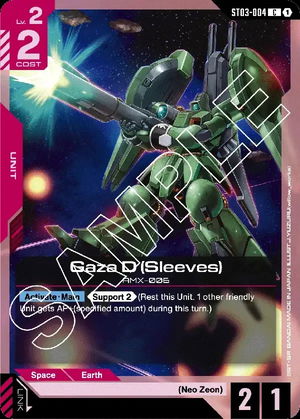
Conclusion
The Gundam Card Game makes good use of a few mechanics seem in other card games, and at the same time adds its own spice, which really gives an identity to the game. This doesn’t mean its overly complex - in fact, it’s very beginner-friendly, specially if you’ve played other Bandai Card Games. Personally, I really value the fact that you can interact on the other player’s turn, which is something I think is really lacking in One Piece TCG.
It’s also interesting to note that the Shield Area cards must have Burst in order to be used once destroyed, which really balances out aggressive strategies, since you’re not necessarily rewarding the opponent for taking damage, like in One Piece TCG.
It’s a really dynamic game, and I’m looking forward for the first competitive events so that I can play. If you want to know more details about the game, check out the official Bandai website in this link!
Hope you enjoyed the article, and let me know in the comments any questions, or feedback! See you next time!








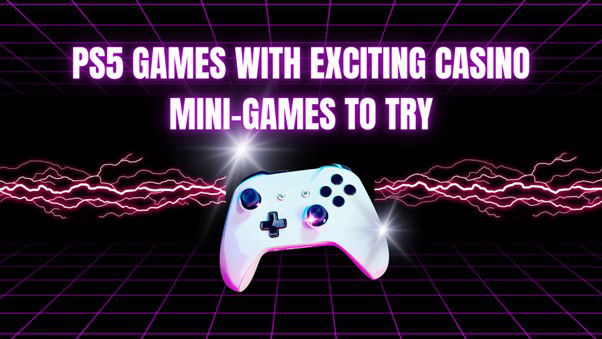

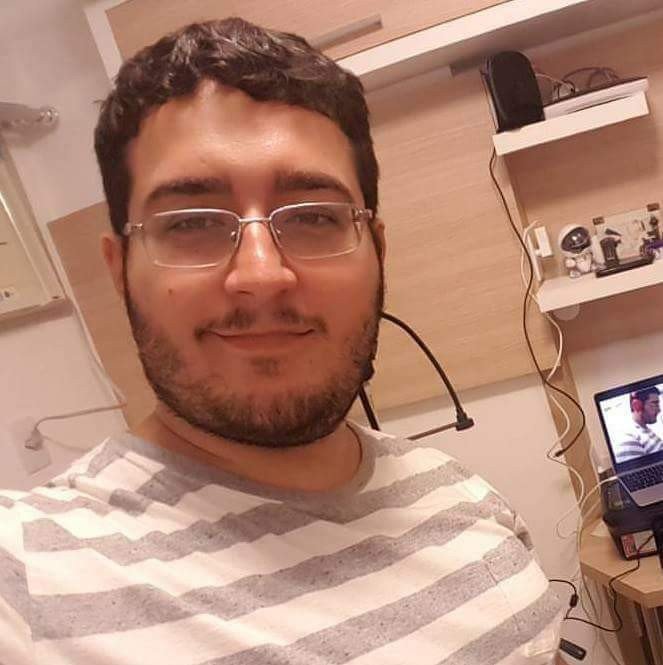
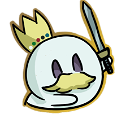
— Kommentare 0
, Reaktionen 1
Sei der erste der kommentiert